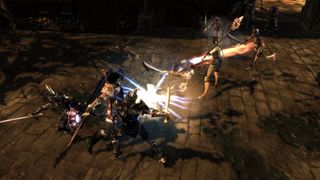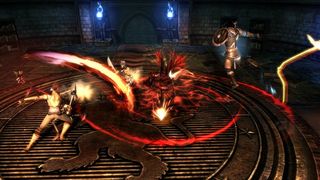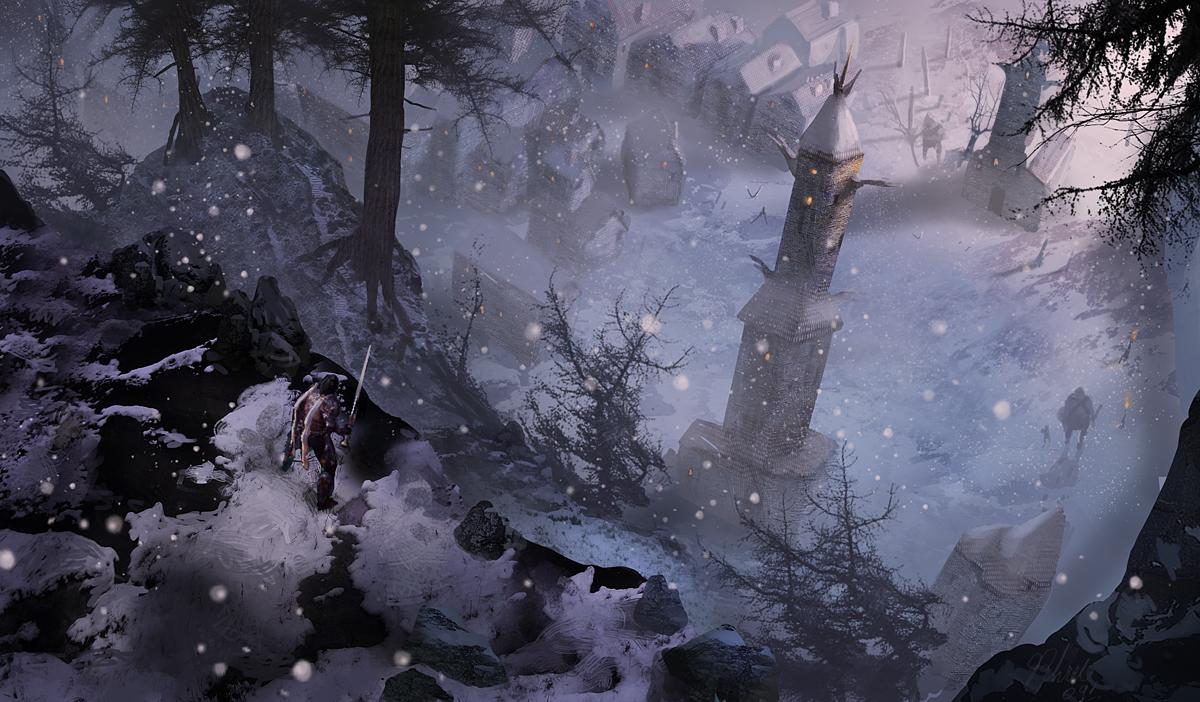Why you can trust GamesRadar+
The towns and other instances of running into NPCs can also slow the pace to a crawl. NPCs begin dialogue similar to Dragon Age and Mass Effect: after an explanation of what’s what, options are presented for more exposition which can increase influence over your AI companion as well as make minor decisions about the overall world, like allying with a particular faction. In the beginning this is fun. By the end, though, you’ll probably skip quickly through dialogue as the decisions you’ve made don’t greatly affect the world. Influence gained over your sidekicks and its use is never fully explained, leading to one to assume it was only there for achievements/trophies, and decisions made over the course of the plot only slightly change the “this is what happened here, and this is what happened here” ending of the game.
The co-op mode is a similar mishmash of undercooked plans. Up to four players (two local and up to four online) can enter a person’s campaign and lend a hand with the thug clubbing. Four people onscreen can really wreak havoc. When everyone’s on the same page, it can make the game quite easy. Most often, though, the more players the more hectic it is. The camera follows the host player. The others have to struggle to adjust to it as they aren’t allowed to leave the host’s radius. In local multi this makes sense since two players are using one screen. Online, though, it’s baffling why everyone can’t follow their own screen. Instead, when the action gets busy, everyone is fighting to go to their specific corner, thus confusing the camera and pissing everyone else off, even though the four of them can logically pound any given target. More baffling is that each player cannot bring their own character build into a multiplayer game, relying on the decisions that the host has made in how they’ve built the allies they aren’t controlling during the main campaign.

Party politics also play a factor. Everyone shares the host player’s bank of money, but they can all go shopping for themselves. When we tested it, each individual player can go to the shop screen and buy their own gear, meaning that if everyone isn’t communicating, player 1 can end up broke before they know it. Dialogue trees with NPCs are also completely at the mercy of the host player, who makes all the decisions. In what feels like a tacked on piece, the other players can cast their vote as to where the conversation can go, but that’s about it.
The plus side is that it’s easy to host and find games. You can set your campaign to let other players drop in and out, and jumping in on a game from the title screen menu is as easy as choosing from the lists available. The one very cool piece of multiplayer is the “take a break” option from the main menu. Since the team cannot move on without everyone following along, you can choose to “take a break” and have AI take over if you need to hit the potty or grab a drink. Of course, trusting a boss fight to it may be less than safe, but it’s a welcome addition to online games.
As a developer, Obsidian has been pretty spotty with how their games perform on a technical level. While not nearly as messy assome oftheir morerecent productions, Dungeon Siege III has a few minor performance gaffes. For one, the brightness and textures of the PS3 version look muddier than on what’s found on 360. Though most won’t find these details too dissimilar, outside of crisper rocks and puddles there are fewer pop-ins and dropped textures in the 360 version as well. Whole walls of dungeons would disappear randomly when played on the PS3. Conversely, the camera rotates in a more stuttered fashion on Xbox than PlayStation. In what was a very odd quirk, the PlayStation version’s multiplayer mode let us hang on to a character in our campaign that the AI took over controlling when the other player had dropped out. This sounds like a small deal, but this is a character we didn’t even meet in our first playthrough until nearly the halfway point of the main game. Bizarre.

The overall game just didn’t seem to be able to catch up with itself. You’ll automatically go into the skill tree after leveling up, but combat must first. Sometimes this is immediate, while often a fight would end and we were left staring at the screen for thirty seconds before something happened. Saving the game is similar - you can’t save until after combat, but sometimes it denies you even with dead bodies everywhere. These and a list of strange omissions that are genre mainstays – no map in the game other than the minimap (seriously), inability to set ally AI behavior, and a lack of a true party of more than two people as in previous Dungeon Siege titles – and it’s clear that DS III was taken out of the oven too early.
Dungeon Siege III is not a game to hate, but there certainly isn’t enough to love. By the end of the campaign we were satisfied with the admittedly-average story, but the stale combat and chaotic multiplayer that are supposed to sell this game just aren’t built well enough. On the cheap, you could probably do worse than this, but we can say for a fact that you can do a hell of a lot better.
Jun 21, 2011
More info
| Genre | Role Playing |
| Description | Dungeon Siege III is not a game to hate, but there certainly isn’t enough to love. |
| Platform | "Xbox 360","PS3","PC" |
| US censor rating | "Teen","Teen","Teen" |
| UK censor rating | "16+","16+","16+" |
| Release date | 1 January 1970 (US), 1 January 1970 (UK) |

